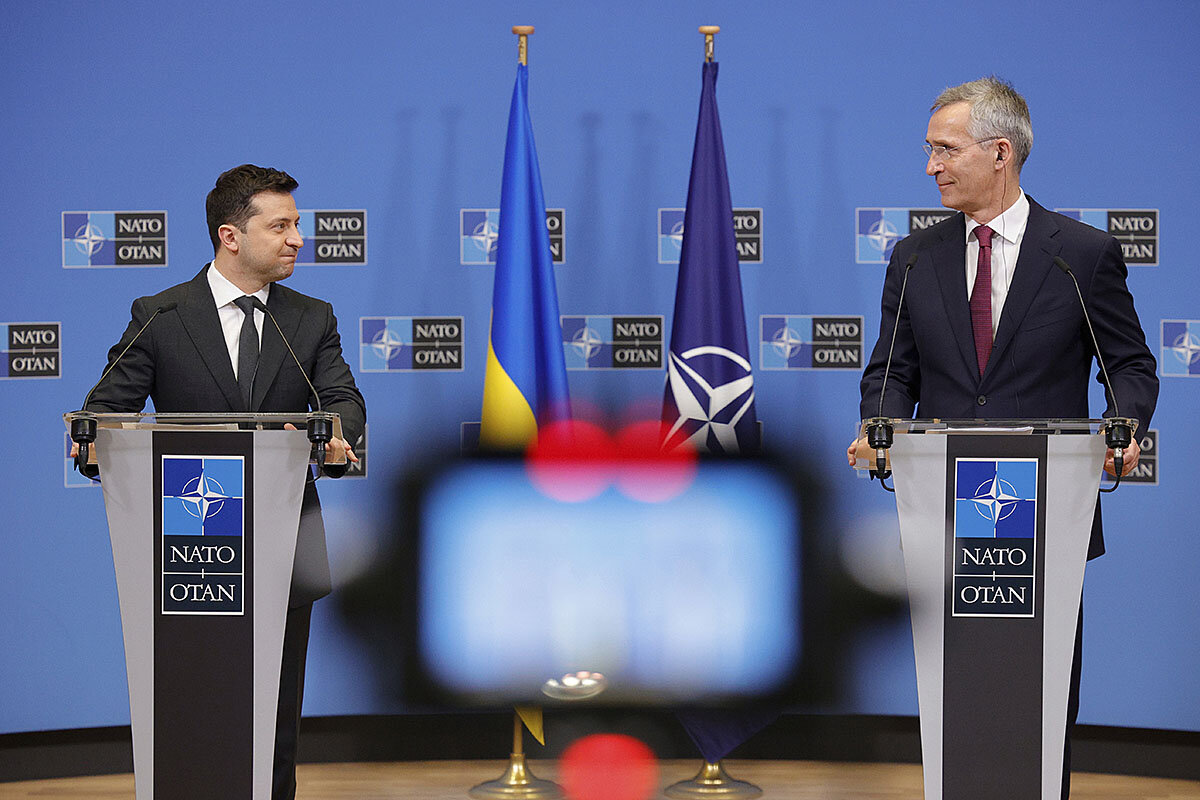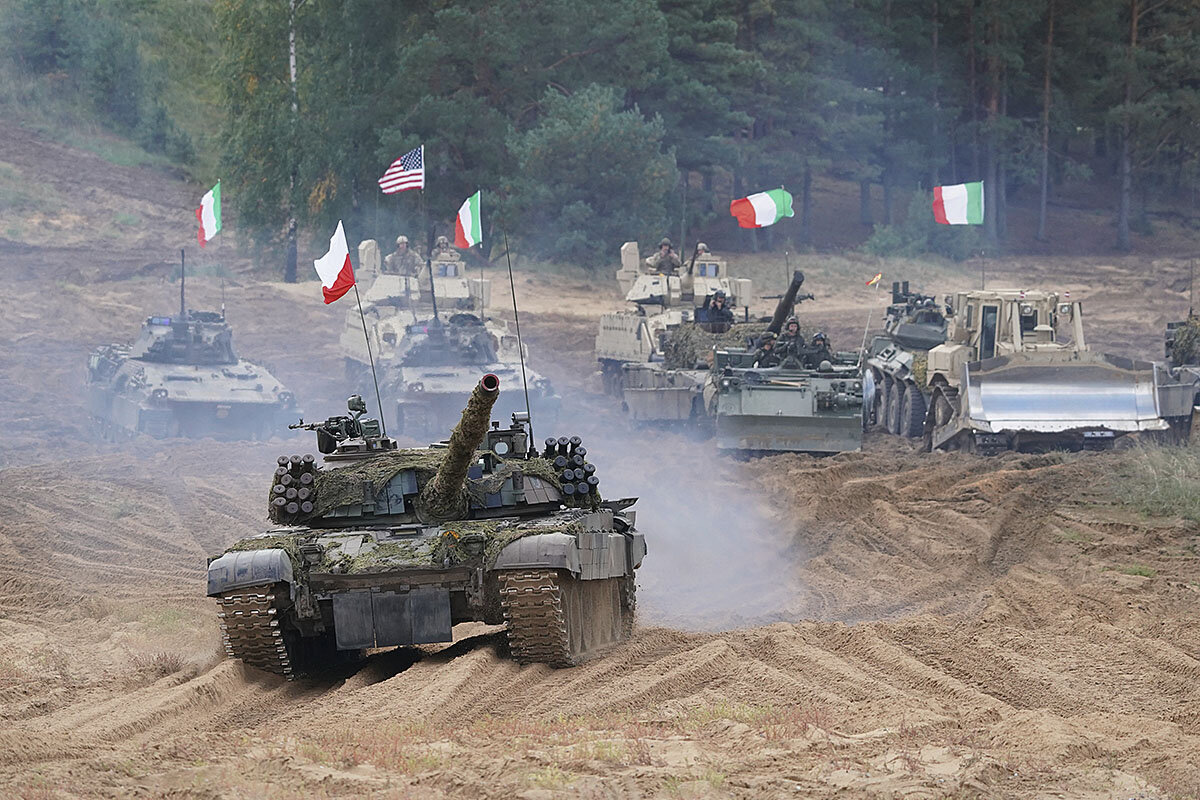NATO says ‘yes, but’ to Ukraine; ‘no, but’ to Putin
Loading...
| Brussels
If Russian President Vladimir Putin’s mass deployment of troops on his country’s border with Ukraine is meant to deter NATO from allowing the former Soviet republic to join its ranks, the Western alliance says publicly that it won’t be pushed around.
“Ukraine has the right to choose its own security arrangements,” NATO Secretary General Jens Stoltenberg reassured Ukrainian President Volodymyr Zelenskyy on Thursday. “And the decision on whether Ukraine can join NATO will be taken by Ukraine and 30 NATO allies alone.”
But that does not mean that the allies are ready to make the former Soviet republic a member. Indeed, behind the scenes “there’s very little enthusiasm” within NATO for bringing in Ukraine, says Ian Lesser, president of the German Marshall Fund of the United States, a transatlantic think tank.
Why We Wrote This
NATO wants to protect Ukraine but is not ready to welcome it as a member. How can the Western alliance walk that line without seeming to bow to Vladimir Putin?
That leaves NATO with a balancing act to retain its credibility: How to reflect the deep doubts within the alliance about the advisability of Ukraine joining, without appearing to bow to Mr. Putin’s insistence that NATO renounce such a step forever.
Plausible steps
NATO has been divided over Ukrainian membership since 2008, when President George W. Bush failed to persuade an alliance summit to invite Ukraine and Georgia into the club immediately. Instead, NATO promised the two states that they could join one day, but without specifying when or how.
That reticence derives from a rarely voiced acknowledgement by some members that Mr. Putin may actually have a point in seeing Ukraine’s potential NATO membership as provocative. “There are a lot of people in powerful positions who think that NATO has pushed things too far,” notes Michael O’Hanlon, a senior fellow at the Brookings Institution.
There is, however, “a consensus on the need to support [Ukraine] politically, economically, and, to the extent they can, in security terms,” says Mr. Lesser.
Today, key to maintaining the alliance’s reputation will be making clear the plausible steps it will take to deter Russia, which means that NATO must “make clear the difference,” between what it will do for its allies, and what it will do for non-member partners, argues Rachel Ellehuus, senior fellow at the Center for Strategic and International Studies and the Pentagon’s principal director for European and NATO policy in the Obama administration.
“While there’s quite a bit that NATO can do,” she adds, “Ukraine is not going to get that Article 5 commitment,” the principle of collective defense at the heart of NATO’s founding treaty, by which an attack against one ally is considered an attack against all.
“If NATO’s going to respond militarily, it’s going to be (through) assistance to (countries) who share a border with Ukraine” to prevent instability in a member state, “which is important to maintaining credibility” within the alliance, Ms. Ellehuus adds.
In NATO’s favor, the Ukrainian armed forces “are far better trained, equipped and resourced, and are more motivated than they were in 2014,” when they failed to repel Russian attacks on Crimea and the Donbas region of eastern Ukraine, Luke Coffey, director of the Allison Center for Foreign Policy at the Heritage Foundation, said in a panel discussion in Washington, D.C. this week. “The Ukrainians can fight for themselves.”
Talks on the agenda
Meanwhile, Russia’s military moves do appear to be bringing some new NATO thinking to the surface, observers say.
“I think that NATO leaned too far forward…when it said that Ukraine will become a member someday,” Ms. Ellehuus says. “They keep saying the door to membership is open when in reality it isn’t. A little more honesty and pragmatism is in order.”
Retracting the promise of membership would likely be impossible. “It would look like a reward for Putin’s bad behavior,” says Mr. O’Hanlon. But U.S. President Joe Biden has already indicated that he is prepared to listen to Moscow’s concerns.
A day after his conversation with Mr. Putin, Mr. Biden said he hoped to convene high level talks between NATO allies and Moscow “to discuss the future of Russia’s concerns relative to NATO writ large.” The talks would explore “whether or not we can work out any accommodation as it relates to bringing down the temperature along the eastern front,” Mr. Biden added.
On Thursday, NATO’s top body pledged that “we are ready for meaningful dialogue with Russia. We are aware of Russia’s recent European security proposals. We are clear that any dialogue with Russia would have to proceed on the basis of reciprocity.”
That suggests that Mr. Putin has achieved the first goal of his military saber-rattling: to make his voice heard.
Russia may seek “certain commitments over Ukraine, and we’re probably not willing to provide those,” says Mr. Lesser. “But above all, Russia wants to feel as if it has a seat at the table and is taken seriously as a great power, which its nuclear status certainly gives it,” he adds. “There has been a tendency not to take Russia very seriously over the past decades, rightly or wrongly.”
Top-level talks between NATO and Russia – and especially between Washington and Moscow – are “badly needed,” says Mr. Lesser. “There was more strategic dialogue, more understanding of what we meant when we said certain things” at the height of the Cold War than there is today, he laments.
The key to NATO credibility in future will be framing the conversation in terms favorable to the alliance, suggests Mr. O’Hanlon. “We should begin by saying that we are actually in the driver’s seat. We’re not asking Putin for favors, and he’s not winning,” he says.
At the same time, it may be helpful “to remind people that NATO allies have been successful in punishing Russia for its provocations,” he adds. Recent annual GDP growth rates have averaged below 2%, a reflection of long-stagnant oil prices and corruption, but also the result of sanctions and a lack of Western investment.
And, as President Biden has reiterated, things could get far worse financially for Moscow, Mr. O’Hanlon points out. “If he were to do something more dramatic, like the invasion of Ukraine, we would respond more strongly and place Russia on a path to recession,” he predicts. In such a scenario, European allies have warned Moscow of “massive” economic consequences.








